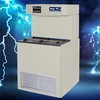Particle Analyzers
(227 companies)
Particle analyzers are used to determine the physical makeup of individual particulates in aerosols, dispersion, emulsions, powders, and other samples.
Texture Analyzers
(39 companies)
Texture analyzers evaluate the cohesiveness, spreadibility, fracturability, tackiness, gumminess, firmness, pliability, consistency and other texture characteristics of foods, rubber, foams, coatings, grease, asphalt and other materials.
Specialty Abrasive Grain and Finishing Media
(129 companies)
Specialty abrasive grain and finishing media include glass beads, sodium carbonate, walnut shells, corn cobs, sponge, hardwood, coal slag and other organic materials as well as other unique compositions or materials for specialized processing.
Bus Analyzers and Bus Exercisers
(23 companies)
Bus analyzers and bus exercisers are used to monitor and check the performance of a system bus.
Elemental Analyzers
(63 companies)
Elemental Analyzers are used for analyzing the Carbon, Hydrogen, Nitrogen, Oxygen, and Sulfur content of organic materials.
Vector Network Analyzers
(68 companies)
Vector network analyzers (VNA) measure the complex transmission and reflection characteristics of two-port devices in the frequency domain.
Audio Analyzers
(44 companies)
Audio analyzers measure the noise and audio spectrum of output from an amplifier or a stereo.
Optical Spectrum Analyzers
(66 companies)
Optical spectrum analyzers (OSA) can divide a lightwave signal into its constituent wavelengths. This means that it is possible to see the spectral profile of the signal over a certain wavelength range.
Residual Gas Analyzers
(101 companies)
Residual gas analyzers (RGAs) identify the gases present in vacuum environments.
Laser Beam Analyzers
(37 companies)
Laser beam analyzers are used to determine the quality of a laser beam.
Scalar Network Analyzers
(49 companies)
Scalar network analyzers measure the amplitude portion of scattering or S-parameters, reflection and transmission coefficients between the incident and reflection waves that describe a device’s behavior under linear conditions at the microwave frequency range.
Power Quality Analyzers and Monitors
(239 companies)
Power quality analyzers measure and monitor electrical power parameters to avoid disturbances, track steady-state variations, and ensure the reliability of power distribution systems.
Vibration Measurement Instruments and Vibration Analyzers
(356 companies)
Vibration measurement instruments and vibration analyzers are used for measuring, displaying and analyzing vibration. Typically these instruments comprise a transducer, data acquisition and either a local display or some sort of output to a computer or another instrument.
Scales and Balances
(936 companies)
Local gravity -- Readouts can change +-.05% depending upon the global location in which the object is measured. Air currents -- Drafts and wind can affect the readouts of very sensitive scales, and in laboratories a draft shield is recommended. Moisture...
Calorimeters and Thermal Analyzers
(116 companies)
Calorimeters and thermal analyzers contain a heat source that can deliver a heat flux, at a distinct temperature, into a sample, and a temperature-measuring device that can read the resultant change in temperature.


